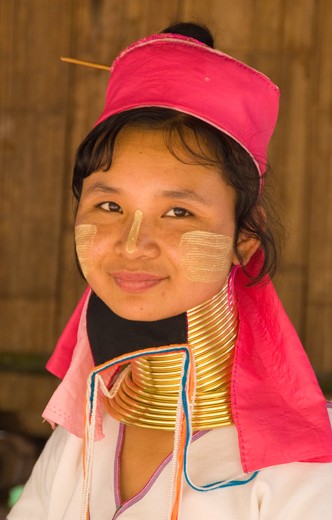Features on Asian Art, Culture, History & Travel
Archives
Archives > BURMA / MYANMAR > Beauty Secrets Of The Padaung

Beauty Secrets Of The Padaung
A Unique Cultural Tradition in Mae Hong Son
SEE RELATED IMAGES @ PICTURES FROM HISTORY
Both Western and Asian accounts of the "Long Neck" Padaung women tend – understandably – to stress the "neck-lengthening" effects of the massed brass coils. And why should they not, when even the Padaung themselves, from their creation myth to everyday speech, stress the aesthetic beauty of long necks? Yet, truth to tell, the neck vertebrae of "Long Neck" women do not stretch, lengthen, or become dislocated – though the muscles which would normally support the neck and head atrophy and lose much of their strength.
Rather, as can clearly be seen from X-rays, the weight of the massed brass rings (usually about 5 kilograms, but in some of the more affluent ladies as much as 8 kilograms) combine to push the chest down, bending and depressing clavicles and ribs alike. As a result the neck looks elongated – but it isn't.
The first brass rings are put on a young Padaung girl's neck at about five years of age in an important rite of passage which – in the case of non-Christian Padaung – is supervised by a village shaman who casts chicken bones to determine an auspicious date. Additional loops are added from time to time as the girl passes through childhood and puberty to reach adulthood.
Generally speaking, the rings – which represent wealth, social status, and feminine elegance – are never taken off. Every day the Padaung women have to spend a considerable period of time meticulously cleaning and drying the rings. For comfort, a small, elaborately-embroidered pillow is inserted above the uppermost coil to cushion the chin. At times of ceremony the brass loops may be draped with additional silver chains and old silver coins to add to the overall effect (and weight!)
Negative effects of the "Long-Neck" process, which Padaung women acknowledge but say they don't mind, include difficulty in drinking. The height and stiffness of the brass collar prohibits drinking in the usual fashion by throwing the head back, and Padaung Long Necks must spend their lives leaning forward to sip through a straw. At night the women sleep on the other side of the family hearth from their husband, using a special pillow to cushion their neck and head. In normal circumstances, a woman's brass rings remain with her even after death, accompanying her to the grave.
In the past, one circumstance under which the rings might be removed in life was as a punishment for adultery. The object of this punishment was ritual humiliation, but the result was sometimes suffocation, as the atrophied neck muscles might fail to support the head.
Under the influence of Christian missionaries the practice of wearing neck coils went into decline during the early 20th century, and some women went so far as to remove their rings voluntarily. In such circumstances it was found necessary to wear a brace to support the neck until the muscles were rebuilt through exercise.
More recently there has been something of a resurgence in the uniquely Padaung custom of wearing neck coils. This is partly due to a resurgence of cultural pride, and partly due to financial circumstances. In the past there was no tradition of mass tourism in the Padaung homelands of Mong Pai. Today, however, Burma's military rulers – who are desperate for hard cash – are throwing the country open to tourism with unparalleled haste. If a peace agreement with the Karens can be agreed, and if the Padaung do manage to return to their landmine-strewn homelands, their experience as "exhibits" in Thailand's mass tourism industry will almost certainly ensure the perpetuation of the "Long Neck" tradition back home.
SEE MORE PADAUNG IMAGES @ PICTURES FROM HISTORY
Text by Andrew Forbes; Photos by David Henley & Pictures From History - © CPA Media
